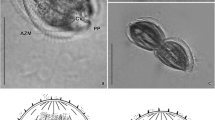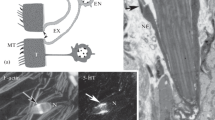Abstract
Platyhelminths, like many other organisms, are capable of producing mineral concretions. In cestodes these are referred to as calcareous corpuscles. Studies on these concretions in different cestodes both in vivo and in vitro have resulted in a number of hypotheses on their origin, formation, and structure. Calcareous corpuscles are believed to be of cellular origin, although the kind of cell involved and the mechanisms of mineralization remain under discussion. In the present paper we show that formation of calcareous corpuscles in cysticerci of Taenia solium is not of intracellular origin, as described for other cestodes, but occurs extracellularly in the lumen of protonephridial ducts in a way similar to that proposed for trematodes. This finding enhances the function of the protonephridial ducts, at least in the larvae of T.solium, to the roles formerly ascribed to the calcareous corpuscles.
Similar content being viewed by others
Author information
Authors and Affiliations
Additional information
Received: 6 April 1998 / Accepted: 21 July 1998
Rights and permissions
About this article
Cite this article
Varga-Parada, L., Merchant, M., Willms, K. et al. Formation of calcareous corpuscles in the lumen of excretory canals of Taenia solium cysticerci. Parasitol Res 85, 88–92 (1999). https://doi.org/10.1007/s004360050514
Issue Date:
DOI: https://doi.org/10.1007/s004360050514




